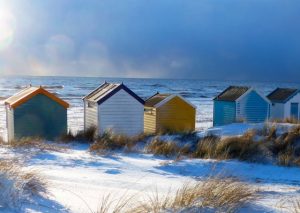Suffolk is a naturally beautiful county that is also rich in history and can be seen in architecture everywhere. Here we offer a guide to Attractions in Suffolk, from RSPB Birdwatching Nature reserves to Historic Houses and Areas of Outstanding Natural Beauty. For ‘activities for all’, please see our Guide to Suffolk Activities ; for lively Days Out with the Children, please see Days Out in Suffolk , and for less vigorous things to do, please see our Things to Do in Suffolk feature.
The National Trust has many outstanding properties in Suffolk, such as Ickworth House near Bury St Edmunds, pictured below –

There are so many we’ve had to list them separately, so for a full listing of all the National Trust properties, please see our guide to The National Trust in Suffolk .
Suffolk played an important role in England’s prosperous wool trade from Medieval times, so you’ll see many old buildings around the county that were once associated with this trade, such as Bosmore Mill in the village of Needham Market, which also boasts a peaceful millpond.

The beautiful Medieval village of Lavenham was one of the 20 wealthiest towns in England in Medieval times due to its role in the wool industry. The Village has retained an almost perfect medieval market square and an Anglo-Saxon Mead Hall – The Guildhall. In many of Suffolk’s towns and villages, there’s a parish church not to be missed, and Lavenham’s (above) contains some prime examples of 15th-century stained glass.

Close by is Long Melford (Village green and Holy Trinity Church pictured above), whose wealth was also derived from the wool trade. The beautiful Holy Trinity Church, sitting atop the hill overlooking Long Melford, has some stained glass windows which survived the Cromwellian destructions (the ‘Clopton Windows’), and together with the historic almshouses nearby forming Trinity Hospital, is well worth a visit. Concerts are frequently held in the Church during the summer.
There are still many 15th-century timber-framed buildings in Long Melford to see.. Additionally, Long Melford boasts the longest High Street in the UK, which has many antique shops, art galleries, boutiques and cafés, and the water meadows behind the High Street are worth a visit too.

Framlingham has a large castle on its hill, dominating the townscape, and is run by English Heritage. Framlingham Castle is a fascinating place to spend a few hours, and Framlingham is a lovely town, so this is well worth a day trip. Click on the link for Framlingham above to find out more about the area.
Woodbridge is an ancient and interesting city that you should not miss. The attractive River Stour and the charming town of Sudbury are among Suffolk’s well-preserved market cities, which are located in stunning countryside abundant in water.

There are also a lot of lively coastal resorts in Suffolk, such as Felixstowe and Lowestoft, Dunwich, which was once a bustling port and features the RSPB Minsmere, Southwold’s unique pier, Aldeburgh, which hosts a range of cultural events, and Orford, whose 90-foot castle towers over it.

The beautiful vistas of Suffolk inspired Constable and Gainsborough to portray the transient light of the English countryside and sky in their paintings. The region known as Constable Country is connected to Flateford Mill and Dedham Vale forever.
Gainsborough was born and bred in Suffolk, and his house in Sudbury is now a museum where you can see some of his work and inspiration – Gainsborough’s House. Local artists continue to draw inspiration from the county – find current Art Exhibitions in Suffolk, so come to Suffolk and be inspired!

